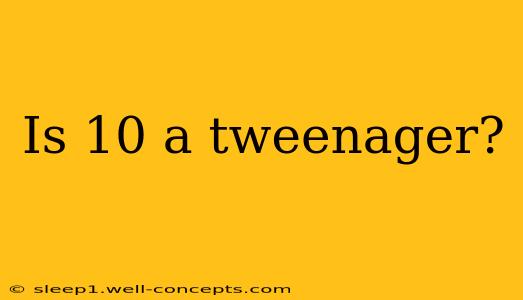The term "tweenager" is often tossed around, but its precise definition can be surprisingly blurry. So, is 10 a tweenager? The answer isn't a simple yes or no. It depends on how you define the term and the context in which you're using it.
Understanding the Tween Years: A Fuzzy Definition
The word "tweenager" itself is a portmanteau of "between" and "teenager," suggesting the transitional period between childhood and adolescence. However, there's no universally agreed-upon age range. While some sources define tweens as children aged 8-12, others place the range between 9-13, or even 10-14. The variability reflects the fact that puberty and the associated developmental changes don't occur at the same age for every child.
Developmental Milestones and the Tween Years
Instead of focusing rigidly on age, it's more helpful to consider the developmental milestones associated with the tween years. These typically include:
- Physical Changes: The onset of puberty, including growth spurts, changes in body composition, and the development of secondary sexual characteristics. These changes can begin as early as age 8 in some children and later for others.
- Cognitive Development: Increased abstract thinking abilities, improved problem-solving skills, and a growing sense of independence.
- Social and Emotional Development: Navigating complex social relationships, developing a stronger sense of self, and experiencing a wider range of emotions. This often includes increased peer influence and a growing desire for autonomy.
So, Is 10 Definitely a Tween Year?
A 10-year-old could very well be considered a tween, especially if they are exhibiting some of the developmental milestones mentioned above. However, a 10-year-old who hasn't yet experienced significant physical changes or shows less developed social and cognitive skills might still be considered closer to the end of late childhood. The variability in individual development makes it difficult to assign a definitive age.
Context Matters
The context in which you're using the term also plays a role. Are you talking about marketing products? A company might target a broader age range (8-12) to encompass a larger market. Are you discussing developmental psychology? A researcher might use a narrower range based on specific study criteria.
Beyond the Label: Focusing on Individual Development
Rather than rigidly defining a 10-year-old as definitively "in" or "out" of the tween years, it's more beneficial to focus on the individual child's development and needs. Each child progresses at their own pace. Observing their physical, cognitive, and socio-emotional development provides a much more accurate understanding of their stage of growth than simply focusing on their chronological age.
Ultimately, the label "tweenager" is a convenient shorthand, but individual differences should always be taken into account. Instead of assigning a rigid age range, consider the unique developmental journey of each child.

